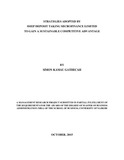| dc.description.abstract | Competitive advantage is the ultimate intention of strategic management; positioning a company
ahead of its rivals through the formulation and
implementation of effective strategies. There is
therefore need for adopting strategies for a sustainable competitive advantage in an ever changing
market environment. In the absence of such strategies, a company can lose its market share or face
the poss
ibility of extinction. This research is a study of SMEP Deposit Taking Microfinance Ltd
(SMEP), which is one of twelve microfinance companies regulated by the Central Bank of Kenya. As
one of the large institutions in the young microfinance industry, a stu
dy of the company would be
an important contribution to the body of knowledge in the industry. The objective of this study is to
determine the strategies adopted to give SMEP Deposit Taking Microfinance Ltd a sustainable
competitive advantage. This researc
h used the case study method employing both primary and
secondary data. Primary data was gathered through in
-
depth interviews with the Chairman, Chief
Executive Officer, and Senior Managers of SMEP Deposit Taking Microfinance Ltd. Secondary data
was collec
ted from SMEP
‟
s strategic plan, audited financial statements, operational reports, and
various internet sites. Reports from the Central Bank of Kenya website were used to establish the
client base and loans advanced to customers of SMEP
‟
s competitors. The
data was collected for the
five year strategic period from 2007 to 2011. Additional data for the years 2012, 2013, and 2014
was also collected to assess the effect of the strategies adopted after the strategic period. The
findings show that SMEP
‟
s financia
l performance improved in the strategic period as a result of
strategies that were effective to realize growth objectives. The market share however, remained
unchanged within the strategic period but assumed a declining trend thereafter. This implies that
SMEP
‟
s strategies have seen the company grow in size but not on competitiveness. In addition, the
company only managed to defend its position within the industry in the strategic period, but the
market share is threatened subsequently. In conclusion, SMEP
needs to specifically target
increasing the market share by employing those strategies that will defend the current market
share and those that will effectively encroach on the markets of her competitors. The result of this
study provides insights into the
factors at play within the competitive microfinance industry and
how those factors can inform strategic formulation and implementation to secure a sustainable
competitive advantage. The study further bridges the competitive advantage theory and practice.
The study recommends more research on competitive advantage in the financial sector. More
studies on sustainable competitive advantage of microfinance banks would add to the body of
knowledge of the fairly young regulated microfinance industry. | |

